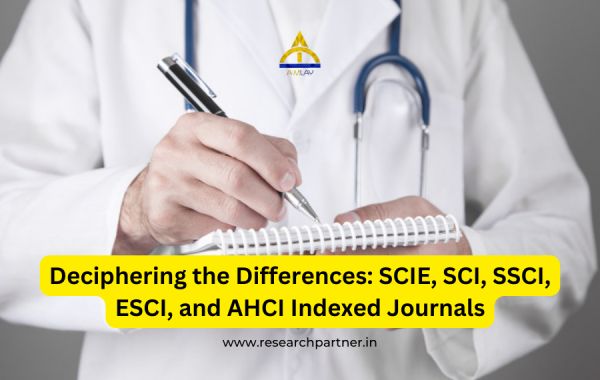Introduction
Finding the right academic journals for your research can be confusing. You might have heard of SCIE, SCI, SSCI, ESCI, and AHCI, but what are these acronyms, and how are they different from each other? In this guide, we'll break it down in simple terms, explaining what each of these indexing systems means and why they matter.
What Do These Acronyms Mean?
Before we dig deeper, let's understand the acronyms:
SCI/SCIE (Science Citation Index/Science Citation Index Expanded): These are part of a database called the Science Citation Index, which covers a wide range of scientific topics. Journals listed here are known for their high quality and thorough peer review.
SSCI (Social Sciences Citation Index): This is another part of the Science Citation Index, but it focuses solely on the social sciences. It's a go-to resource for researchers in psychology, sociology, economics, and similar fields.
ESCI (Emerging Sources Citation Index): This index is like a stepping stone. Journals listed here are on their way to being included in SCI/SCIE or SSCI, which means they're gaining recognition.
AHCI (Arts Humanities Citation Index): This is also part of the Science Citation Index, but it's dedicated to journals in the arts and humanities. If you're into literature, philosophy, history, or the arts, AHCI is where you want to look.
Why Are These Indexes Important?
Being part of these databases can boost a journal's reputation and make your research more visible. Here's why these indexes matter:
Credibility: Journals in these databases are known for their rigorous review processes, ensuring that the research they publish is trustworthy.
Visibility: Researchers use these indexes to find relevant articles. Being in these indexes means more people are likely to see your work.
Impact Factor: Journals in SCI/SCIE, SSCI, and AHCI get an "Impact Factor," which measures how influential a journal is in its field. Higher Impact Factors mean more recognition.
Now, let's explore the differences between SCI/SCIE, SSCI, ESCI, and AHCI indexed journals.
Understanding the Differences
Each indexing system serves a specific purpose and covers different subjects. Here's what sets them apart:
1. SCI/SCIE (Science Citation Index/Science Citation Index Expanded)
Science Citation Index (SCI) and Science Citation Index Expanded (SCIE) are all about science but with a few distinctions:
Comprehensiveness: SCIE covers a broader range of scientific fields compared to SCI. So, it includes more topics and sub-disciplines.
Impact: Journals in SCI/SCIE are known for their significant impact in the scientific world. They're considered very prestigious.
How to Find SCI/SCIE Journals:
Official Websites: Clarivate Analytics, which manages these indexes, has a list of journals on their website.
Journal Websites: Many journals proudly say they're in SCI/SCIE on their websites.
Online Directories: Websites like Ulrich's Periodicals Directory and the Directory of Open Access Journals have lists of SCI/SCIE journals.
2. SSCI (Social Sciences Citation Index)
Social Sciences Citation Index (SSCI) is all about social sciences, like psychology and economics:
How to Find SSCI Journals:
Official Websites: Clarivate Analytics has an official list of SSCI journals on their site.
Journal Websites: Journals often mention their SSCI status on their websites.
Library Resources: If you're in a university, your library can help you find SSCI journals.
3. ESCI (Emerging Sources Citation Index)
Emerging Sources Citation Index (ESCI) is a bit different. It's for journals trying to get into SCI/SCIE or SSCI:
How to Find ESCI Journals:
Official Websites: Clarivate Analytics lists journals in ESCI on their website.
Journal Websites: Journals in ESCI often mention it on their sites.
Database Searches: Some academic databases let you filter results to include only ESCI journals.
4. AHCI (Arts Humanities Citation Index)
Arts Humanities Citation Index (AHCI) is for arts and humanities:
How to Find AHCI Journals:
Official Websites: Clarivate Analytics provides an official list of AHCI journals.
Journal Websites: Journals often say they're in AHCI on their websites.
Library Resources: University libraries typically have databases listing AHCI journals.
Conclusion
Now that you understand the differences between SCIE, SCI, SSCI, ESCI, and AHCI indexed journals, you can make better decisions about where to publish your research or find relevant articles. Keep in mind that the world of academic publishing is always changing, so staying updated on the latest developments in your field is essential.







